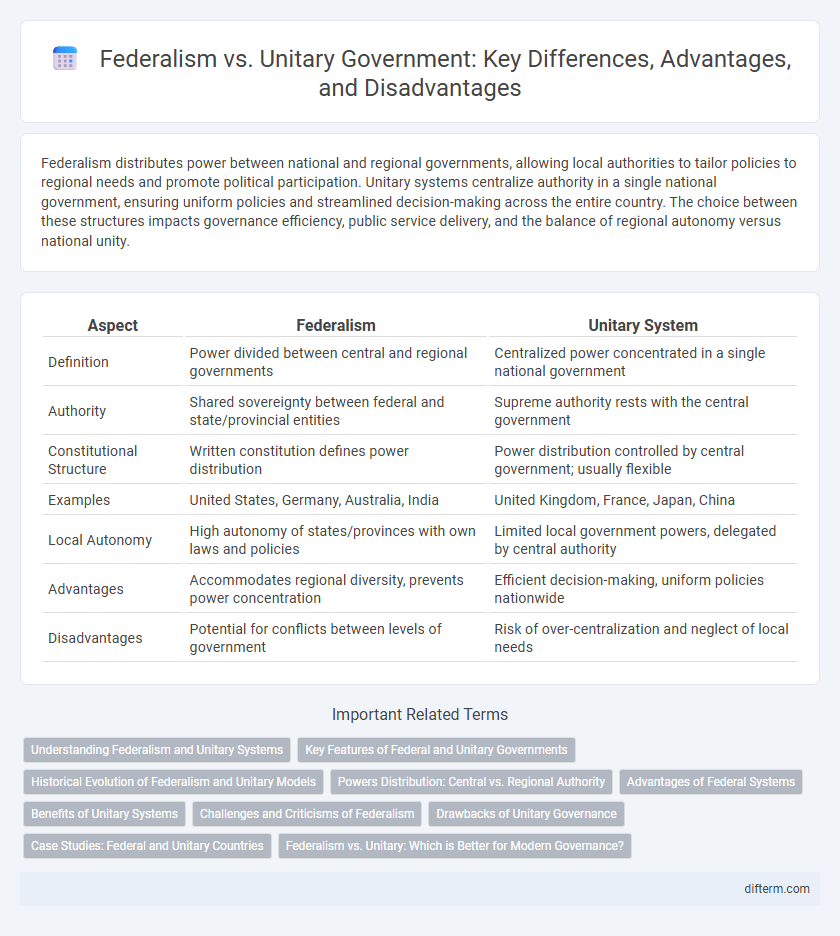Federalism distributes power between national and regional governments, allowing local authorities to tailor policies to regional needs and promote political participation. Unitary systems centralize authority in a single national government, ensuring uniform policies and streamlined decision-making across the entire country. The choice between these structures impacts governance efficiency, public service delivery, and the balance of regional autonomy versus national unity.
Table of Comparison
| Aspect | Federalism | Unitary System |
|---|---|---|
| Definition | Power divided between central and regional governments | Centralized power concentrated in a single national government |
| Authority | Shared sovereignty between federal and state/provincial entities | Supreme authority rests with the central government |
| Constitutional Structure | Written constitution defines power distribution | Power distribution controlled by central government; usually flexible |
| Examples | United States, Germany, Australia, India | United Kingdom, France, Japan, China |
| Local Autonomy | High autonomy of states/provinces with own laws and policies | Limited local government powers, delegated by central authority |
| Advantages | Accommodates regional diversity, prevents power concentration | Efficient decision-making, uniform policies nationwide |
| Disadvantages | Potential for conflicts between levels of government | Risk of over-centralization and neglect of local needs |
Understanding Federalism and Unitary Systems
Federalism divides power between a central government and regional governments, allowing states or provinces to exercise autonomous authority within their jurisdictions. Unitary systems centralize authority in a single national government, with administrative divisions operating primarily as extensions of central control. Understanding federalism involves analyzing the balance of power and decentralization, while unitary systems emphasize uniform policies and centralized governance.
Key Features of Federal and Unitary Governments
Federal governments feature a division of power between central and regional authorities, allowing states or provinces to maintain legislative autonomy and distinct policy-making responsibilities. Unitary governments centralize authority within a single national government, streamlining decision-making and policy enforcement across all regions without autonomous regional legislatures. Both systems impact administrative efficiency, local governance, and the balance of political power within a country.
Historical Evolution of Federalism and Unitary Models
The historical evolution of federalism traces back to the formation of the United States Constitution in 1787, establishing a balance of power between national and state governments to accommodate diverse regional interests. Unitary models, exemplified by France since the French Revolution of 1789, centralized authority to maintain national unity and streamline administrative control. Over time, federal systems expanded in countries like Germany and Canada to manage ethnic diversity and local governance, while unitary states adapted through decentralization reforms without compromising centralized sovereignty.
Powers Distribution: Central vs. Regional Authority
In federalism, powers are constitutionally divided between central and regional governments, allowing regional authorities significant autonomy in legislative, executive, and fiscal matters. Unitary systems concentrate authority within a central government, which may delegate powers to subnational units but retains ultimate control. This fundamental difference affects how policies are implemented and how local needs are addressed within each governance model.
Advantages of Federal Systems
Federal systems offer enhanced regional autonomy, allowing diverse local governments to tailor policies that address unique cultural, economic, and social needs. This decentralization fosters innovation and experimentation in governance, as states or provinces can implement and test policies independently before national adoption. Moreover, federalism promotes political participation by bringing government closer to citizens, increasing accountability and responsiveness at multiple levels.
Benefits of Unitary Systems
Unitary systems centralize authority, enabling streamlined decision-making and consistent policy implementation across the entire nation. This centralization reduces administrative costs and eliminates duplicative government functions found in federal systems. Uniform laws and regulations foster national unity and simplify governance, benefiting both citizens and businesses.
Challenges and Criticisms of Federalism
Federalism often faces challenges such as overlapping jurisdictional authority leading to legal ambiguities and inefficiencies in policy implementation. Critics argue that federal systems can exacerbate regional inequalities and create barriers to national unity by empowering subnational entities with disproportionate influence. Conflicts between federal and state governments frequently result in costly litigation and hinder coherent national policymaking.
Drawbacks of Unitary Governance
Unitary governance often leads to excessive centralization, which can result in slower decision-making and reduced local autonomy. This concentration of power can hamper responsiveness to regional needs and diminish the effectiveness of public service delivery. Furthermore, the lack of local representation may foster dissatisfaction and weaken the connection between citizens and government institutions.
Case Studies: Federal and Unitary Countries
Federal countries like the United States, Germany, and Australia demonstrate how power is constitutionally divided between national and state governments, allowing regional autonomy and tailored policies. In contrast, unitary states such as France, Japan, and China centralize authority in the national government, promoting uniformity and streamlined decision-making across all regions. Case studies reveal federalism often supports diverse societies with multiple ethnic groups, while unitary systems excel in maintaining national cohesion and policy consistency.
Federalism vs. Unitary: Which is Better for Modern Governance?
Federalism distributes power across multiple levels of government, enabling regional autonomy and local decision-making, which can enhance responsiveness and accommodate diverse populations within a nation. In contrast, unitary systems centralize authority, allowing for uniform policies and streamlined administration but often at the expense of local adaptability and regional representation. Modern governance benefits from federalism's balance between unity and diversity, fostering political stability and tailored policy solutions in complex, heterogeneous societies.
federalism vs unitary Infographic

 difterm.com
difterm.com